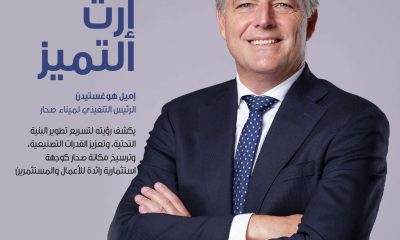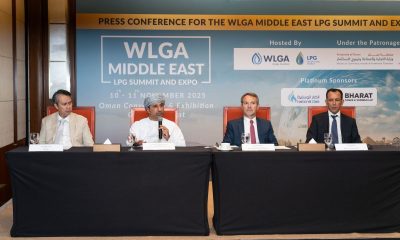Special Reports
Laying the tracks of growth
With the multi-billion-dollar GCC railway network project gathering momentum after a brief lull, Oman is gearing up to start the construction of the first segment of its 2,135-km long national railway network by mid-2015. The prestigious national project has the potential to rewrite the dynamics of logistics in the country and foster one of the most sweeping development transitions in modern Oman.

With the multi-billion-dollar GCC railway network project gathering momentum after a brief lull, Oman is gearing up to start the construction of the first segment of its 2,135-km long national railway network by mid-2015. The prestigious national project has the potential to rewrite the dynamics of logistics in the country and foster one of the most sweeping development transitions in modern Oman.
“The train has departed. We are all on board,” that was how HE Dr Abdul Latif bin Rashid al Zayani, secretary-general of the Gulf Cooperation Council (GCC), set the tone for a high-level panel discussion at GCC Rail and Metro Conference hosted by Oman in January 2015. Seemingly undeterred by a witty rejoinder from moderator Tim Sebastian as to why the train is getting delayed, he retorted, “It’s good to be a bit late but moving, than to rush.”
The optimism in his words, albeit guarded, and the air of buoyancy exuded by the policy makers and top officials from different countries, sought to alleviate misgivings about the future of one of the most prestigious and path-breaking infrastructure projects in the GCC region—the ambitious, multi-billion-dollar railway network stretching from Kuwait City all the way along the Gulf coast and across the Hajar Mountains to Muscat.
The project had been moving at a slower pace, leaving plenty room for naysayers to doubt the political will behind it and its economic viability. It took a while for the technical and operational guidelines to be finalised, and plans for a common regulatory body were still in pipeline, while the unprecedented decline of oil prices, they assumed, came in the form of a double whammy. But Al Zayani brushed aside all such concerns reiterating the political will of the member states ‘to see the project come to fruition’. “The technical specifications and standards for the network had been agreed and work was now being done to put a regulatory framework in place to cover the system”, he said. “The commitment is there. I am very happy that this project is seeing the light. The focus is on getting all studies completed this year so that we can start the actual project on time and hopefully get it commissioned by 2018”.
A critical milestone of the project will be awarding contracts for the whole line to the contractors. Within the next 12 months, member states need to finalise contract awards, the regulatory framework and operator agreements. Giving a broader picture of the entire project in the long term, HE Dr Ahmed bin Mohammed bin Salim al-Futaisi, Oman’s Minister of Transport and Communications, explained, “More than $200bn is set to be invested in over 40,000km of rail and metro projects across the GCC over the next 20 years. Our challenge will not just be in how to ensure the success of executing these projects from a technical and operational point of view, but on how to exploit the socio-economic potential of these massive investments so to ensure the multiplier effect into our economies.”
Oman’s gateway to the world
The leitmotif of Oman’s future growth and economic diversification plan has been to reinvent the Sultanate as a regional logistic hub and explore its potential as an international freight gateway. The vision and strategy for Oman’s future economic growth has always pivoted around a few of its iconic infrastructure projects. Commercial ports and freezones in Sohar, Salalah and Duqm capable of handling large ships and significant volumes of international cargo; five airports and a sound network of roads that include express ways have been touted to represent a resurgent and futuristic Oman, which is ambitiously looking to diversify its economy away from hydrocarbons. And now comes the crowning glory of all these pillars – the national railway network that serves as the key to connect this entire infrastructure and will be instrumental in fostering one of the most sweeping development transition in modern Oman.
The Sultanate’s 2,135-km long national railway network will be rewriting the dynamics of logistics in the country. Overall, the project is divided into three phases. Phase one will connect the three ports—Sohar, Duqm, and Salalah—to the GCC network on Oman’s north-west border with the UAE, while the phase two will connect the other economic hubs and commercial centers. Phase three is a long-term development for connecting other cities and towns. However, for easy implementation, the project is divided into nine segments. The first segment includes a 135-km stretch from the Port of Sohar to the border with the UAE at Hafeet; a 34-km spur connecting Hafeet to Buraimi; and an additional 38-km spur connecting the port to a new railway yard in Sohar.
To build the first 207-kilometre long Sohar-Buraimi segment, 18 consortiums for civil infrastructure and five for technology systems were pre-qualified. The qualification process was reviewed by a team of international rail development experts. The pre-qualified companies for civil infrastructure include some of the largest construction firms and industrial heavyweights from across the world while the consortia for technology systems include Ansaldo STS (Italian); Bombardier (Canadian); Siemens (German) and Thales and Alstom (French). On January 18, 2015, the pre-qualified companies submitted technical bids to build the first segment, while the commercial or financial bids for the same segment will be submitted in March. The government plans to award an engineering, procurement and construction (EPC) contract for the first segment by the middle of 2015.
Says HE Al Futaisi, “We expect to announce the contractor for the first segment by the middle of this year. The other segments are still in the design stage, and we hope to float some additional segments within this year. It has been announced by the Minister of Finance that at least segment one is included in this year’s budget.”
According to Eng Abdulrahman al Hatmi, CEO, Oman Railway Company, an independent government-owned entity which came into being in early 2013 with a mandate to oversee and implement the design, tendering and construction of the rail network, two more tenders are expected by the end of 2015. “We are still trying to identify those segments. We want to learn from the current tendering process to prepare different segments for tendering,” he said. He also noted that the design of the remaining eight segments is going on. “Our target is to complete the entire network design by the end of the year.”
Italferr, an Italian engineering firm, is involved in designing routes for the entire network of national railway project. Says Roberto Liuzza, project director, Italferr, Oman branch, “Italferr started to work on the design of the first and second phases, on January 2, 2014. The company met the first deadline to supply the tender documents for the first priority segment, from Sohar to Buraimi, by delivering it on August 14, 2014. The tender is run and managed by Oman Railway Company.”
He adds, “The first part is done; our work covers the technical design of tracks and civil works as well as very advanced technological systems for the centralised control traffic and safety (the ERTMS level 2 system, presently the most advanced in railway systems), technical specifications and tender documents suitable for international tendering. We were able to achieve an important milestone in a very short time (seven months), an achievement that seemed impossible. We managed to achieve this, thanks to the cooperation of the Ministry of Transport and Communications, Oman Rail Company and other stakeholders.”
According to him, Oman and UAE networks are supposed to reach the border in 2018, connecting the first part. Liuzza says Oman’s will be a high-standard railway system. All lines will have double tracks and there will be no level crossing at all. The passenger train’s design speed is 220-km per hour, while the operation speed will be 200-km per hour. Freight trains will be able to run at a maximum speed of 120-km per hour. There will be heavy-load freight trains, which will be better than European quality and on a par with the US standards. The maximum axle load of the freight trains will be 32.4 tonnes, while in Europe it is only 22.5 to 25 tonnes. The higher standards will be maintained for transporting mineral products with heavy loads. The railway can accommodate freight trains of 2000-metre length, while in Europe it is only of 750 to 900 metres. He says particular attention has been given to freight transport, because Oman wants to be an international freight transport gateway and strategy hub, by connecting the ports. “We reviewed the transport study, collected data from different stakeholders, managed and processed the data in order to forecast the future transport demand, for the next 30 years,” adds Liuzza.
Technically challenging
Owing to the challenging geographic terrain in the country, Oman’s rail network requires complex engineering solutions such as tunnels, bridges, and viaducts. Al Hatmy says the network is five times more expensive per kilometre than that of any other GCC state. Italferr which has done a lot of projects in Italy, Saudi Arabia, Emirates, Egypt, Qatar and Syria etc. says the design of Oman’s project has been technically challenging and very different from other neighbouring countries, because of the mountainous terrains in the country, especially in the first segment from Sohar to UAE boarder. “But we are very used to it in Italy, which is a mountainous country,” says Liuzza. “From Sohar to the border, there are a number of important structures and tunnels. Tunnels are unavoidable when you have to cross mountainous terrains. There are 4.5- km of tunnel in this rout in addition to a lot of viaducts for a total length of about 20 kilometers. In fact, this is a very costly infrastructure.”
The next phases from Buraimi to Ibri and to Thumrait cross the desert and there will be no tunnels and very few viaducts. The connection to Duqm will also be through the desert. But there will be a very challenging connection from Thumrait to Salalah, because it involves connecting the desert to the mountain and then going down sharply to the sea level. “We already have a solution to the alignment. We are carrying out the preliminary design for the project with a lot of tunnels, bridges and viaducts.”
Raising the fund
However, the unprecedented decline in the oil prices since mid-2014 has raised concerns about the government’s capability to finance the rail network. Oman Rail has been funded to date by the government, though as construction begins the company is widely expected to seek continued financing elsewhere – potentially on the local or international capital markets. Says HE Dr Al Futaisi, “Oil price is a challenge, of course. But railway is a long-term project having a lot of strategic importance. There is a commitment from all the GCC countries to go ahead with the project, despite the falling oil prices”.
Asked about the total amount allocated for implementing the project, the minister said that it was too early to talk about the exact figure of the whole project. However he explained that the first segment from Sohar to Buraimi has been incorporated in the state budget 2015 and will be financed by the government. “However, our network will be much larger, going to Duqm and Salalah, and we are now studying the financial model for this part. It is going to be a mixture of loans, bonds, government funding etc. We are seriously thinking about different modes of financing for the project.”
Connecting ports
The railway will help Oman to tap fully its potential as a strategic location outside the Strait of Hormuz. Despite being projected as a freight and passenger railway, Oman’s railway network will initially focus on developing cargo capacity. In the phase one of the project, there will be two adjacent tracks designed to carry double-stacked intermodal shipping container cars. As observed by Liuzza, “The first priority phase of Oman’s railway project is to connect all the main ports in the country. Starting form Sohar, which is very close to the UAE boarder, the rail network will be connected to Duqm and Salalah. Connecting ports is part of the national strategy to make Oman an international and intercontinental freight gateway. It will also help Omani economy by boosting exports from the country. Now Oman has also an ambition to be an exporting country.”
Jamal T Aziz, CEO, Sohar Freezone and deputy CEO of Sohar Industrial Port Company corroborates, saying, “Oman has got a very strategic location on the Arabian Sea. Having different means to connect itself with the regional and international market will enhance the Sultanate’s value proposition as a regional and international gateway. Currently, the country is depending on roads which have a limited capacity to carry goods, but the advent of rail will create economies of scale, enabling us to transport huge volumes across the region and beyond”.
The railway network offers abundance of opportunities for importers and exporters who are looking into different means of reducing transport costs. Adds Aziz, “No doubt that it is going to be of high economic value for the country. When we make the logistic chain, it can attract business and create job opportunities.”
Sohar’s strategic gains
Railway is coming at a time when Sohar is on the cusp of a major industrial transformation. The new road, air, and rail links are going to strengthen Sohar’s potential as a regional gateway. Railway will open up new vistas in freight transport and help further explore Oman’s immediate markets in the Middle East. A combination of shipping cargo and on-dock rail services can do wonders for re-exporting commodities. Dockside rail yards move cargo efficiently from container terminals and help reduce the number of trucks on city streets and highways.
Says Andre Toet, CEO of Sohar Industrial Port Company, “A port is dead without hinterland connection. The road to Riyadh that is expected to open in April 2015 will directly connect Sohar to Riyadh, the biggest consumer market in the Middle East. It is a 1,400-kilometre road and will strengthen our gateway position. What happened in Sohar is mindboggling. From the first ship in 2004, Port Sohar has grown to handle 50mn tonnes of throughput in such a short period of time.”
Adds Aziz, “In Oman, you cannot look at the railway independent of ports. Ports and railway have to go together to make Oman an export-oriented economy.” He adds, “We have developed in the freezone several upstream industries like metals and minerals, automotive, general logistics, warehousing and third party logistics (3PL). Currently, we are looking at developing the agro-food sector for processing, distribution and re-export of food products.
Being an industrial zone that generates huge volumes of cargo, Sohar can export massive volumes via rail, once it is in place. In addition, railway will help re-exports, which the port is currently focusing on in a big way. Avers Aziz, “Railway will be instrumental in making Sohar a re-exporting hub especially for automotive and other consumer products to various GCC and Middle East markets. This is what we call a gateway model. We processed more than 120,000 cars in 2014 and are expected to grow it to more than 200,000 cars in the near future. Railway is going to offer a fantastic boost for these activities. A more efficient supply chain attracts business and enables economic growth.”
Talking about the prospective opportunities, he adds, “If Port Sohar continues to grow in the manner we are growing today with massive volumes and we remain competitive in our rates and energy supply, coupled with the upcoming railway, express way networks and the new airport, I believe that Sohar will be a formidable competitor to the leading ports and freezones in the region like Jebel Ali and Khalifa ports.”
In addition, when it comes to railway, Sohar has the unique advantage of being in the beginning of the chain-link or towards the end of it. Says Aziz, “We are not at mid point. The big ships need not come inside the gulf. They can stay outside and drop their cargo from where we can take it by rail to the hinterland, or vice versa in the Gulf and the wider Middle East which is our immediate consumer market.”
The rail will benefit the growth of Sohar freezone in two ways: in terms of freight transportation and the development of ancillary services for the railway. For example, it can have warehousing facilities or a logistic park for cargo destined to go by rail. In addition, the freezone can host several ancillary industries related to the railway such as maintenance, repairing, spare part components etc.
Aziz says, “We are now planning phase 2 for which railway will be very decisive. We have 45 square kilometres of space in the freezone of which we have used only five square kilometres. There are plenty of areas to be expanded. As we have seen in phase 1, the healthy growth of freezone Sohar is closely linked to the growth of the port of Sohar; that is why our brand is ‘Sohar Port and Freezone’. Our growth in the freezone follows the success that we achieved in the port-the growth of business and the growth of shipping networks that are visiting Sohar. So from that sense, we think it is very healthy, and when the rail comes, it will add another dimension to our value proposition, by creating a gateway with a multi-model transport system that can reach even further.”
Ensuring smooth flow
But for this mammoth and ambitious regional rail network to work, the GCC countries need to make sure that there is a seamless cross-border regime in place. “You cannot stop a train midway,” says Aziz. Adds Andre Toet, “If you want to run the trains, the ease of doing business is important. It should be seamless from the terminal into the upper gulf. There should be no stoppage or customs check in between. If you don’t manage the ease of doing business, then your whole rail project could fail. The good thing is that GCC is talking with each other on rules and regulations for custom procedures. The rail has to be seamless, allowing freight to move fast and quick without stoppage.”
The implementation of the GCC customs union has confronted a preponderance of hurdles since its inception in 2003. However there are some positive strides being taken towards enforcing unified procedures in 2015. But without the GCC customs union becoming fully operational, the potential and scope of the railway network in achieving closer regional economic integration and a full-fledged regional common market will be limited. “The GCC rail project is one of a kind, ambitious and complex in nature,” says Dr Ramiz Al Assar, resident World Bank adviser, Gulf Cooperation Council. “It will link six member states as a regional transport corridor, further integrating with the national railway projects, deepening economic social and political integration, and it is developed from a sustainable perspective.”
The regional network is gathering momentum, with all GCC member states geared up to meet the 2018 deadline. Phase one of UAE’s Etihad Rail project, a 264km stretch, has been completed and is now in the testing and commissioning stage. The 628km-long second phase will provide an important link in the GCC network between Saudi Arabia on one border and Oman on the other. Eng Faris Saif al Mazrouei, acting CEO Etihad Rail, said, “(With rail netwrok), the market will get an extra sector, which will provide substanital opportunities for the expansion of both the public and private sectors. We are currently in stage one of testing and commissioning – things are moving ahead as planned.”
Saudi Arabia, the frontrunner of railway in the region, is building a massive network of 5,000km to be completed by 2020. The country has recently signed a deal with a consultant to undertake detailed design work for its 663km-long leg of the GCC rail project. Dr Rumaih M Al Rumaih, CEO of Saudi Arabian Railways (SAR), said, “Already (a stretch of) 1,400km is operational, with the ability to transport phosphate and bauxite from mines to the manufacturing facilities at the port in Ras al Khair. Since the line became operational, we have transported more than 6.5 million tonnes of phosphate. The benefits of using the railway are tangible – we have saved 70 per cent of the fuel that would have otherwise been consumed by trucks.” He adds that the environmental benefits are huge – there will be an estimated 50 per cent reduction of CO2 by using trains to transport goods.
Bahrain is set to complete studies into its rail link to Saudi Arabia by the end of March. There are proposals for two routes for an 87km-long link that will adjoin two stations on either side of the water. On both sides, stations will be built on land reclaimed from the sea. In a second phase, the station on reclaimed land will be linked to Bahrain’s port and airport projects, and eventually onto a proposed causeway to Qatar. Maryam Ahmed Jumaan, the Kingdom of Bahrain’s Under-secretary for land transportation, called for a GCC-wide strategy for managing a supply chain, with a co-ordinated approach to procurement and an agreement for different elements of rail systems to be manufactured within individual states. “All of the projects taking place at the same time means all member states are competing for resources. To have a strategy to manage that, I think, is key to making sure costs are not inflated and that objectives are met. I’m not aware that there is any GCC wide strategy or study to look at that but there needs to be.”
As the railway is about to enter the gulf in a big way, trumpeting a sea change in the passenger and freight transport of the region, the governments have to lay the groundwork to usher in a new era in transportation. Moreover, as the GCC countries brace themselves for a post-hydrocarbon era with an aggressive focus on diversification, the GCC train cannot be delayed further.
-

 Magazines2 months ago
Magazines2 months agoOER – September 2025 Issue
-

 Alamaliktistaad Magazines2 months ago
Alamaliktistaad Magazines2 months agoAlam Al Iktisaad – September 2025 Edition
-

 News1 month ago
News1 month agoKitchenomiKs Secures Investment of US$3.2M Led by Jasoor Ventures
-

 News2 months ago
News2 months agoCent Capital, AI Finance App by ex-AWS Strategist ‘The Beast of Bay Area,’ Launches to End Financial Anxiety, Hits $1M AUM
-

 News2 months ago
News2 months agoOman Inaugurates ‘Hadatha’ – Its All-New Cybersecurity Center
-

 Banking & Finance2 months ago
Banking & Finance2 months agoOman Arab Bank Highlights Its Ongoing Strategic Initiatives and Future Plans
-

 News2 months ago
News2 months agoIEA Expects Global Oil Market to Remain Oversupplied in 2026
-

 Energy1 month ago
Energy1 month agoWLGA Middle East LPG Summit & Expo 2025 to be held at OCEC on November 10 and 11































You must be logged in to post a comment Login